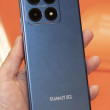reception between verizon and cingular - no flaming please
i live in riverdale NY. the reception outside, on the street, is good with several verizon phones and 2 friends cingular. when i try to use the phones in my appartment building or a local school (ps81), verizon starts to get poor voice quality, drop calls, or no signal. cingular works perfectly. i was told by verizon CS that i have a verizon cell tower about .5 miles from me. why is there such a difference.
any ideas???
thanks
Hope it helps.
Someone made a reference in regards to frequency; yes frequency matters--> lower frequency works better indoors. To tell what frequency your phone is picking up just look at the symbol next to the bars of signal strength; a 1X is the higher frequency and a D is lower. If you live in a well populated city more than likely you will see a the 1X, it goes to D if 1X is not available or the settings have been altered.
In regards to phones; yes some work better than others in buildings. However, it comes down to the building material, cell site relation to ...
(continues)
schnozejt said:
Someone made a reference in regards to frequency; yes frequency matters--> lower frequency works better indoors. To tell what frequency your phone is picking up just look at the symbol next to the bars of signal strength; a 1X is the higher frequency and a D is lower. If you live in a well populated city more than likely you will see a the 1X, it goes to D if 1X is not available or the settings have been altered.
That is not entirely true. That is implying that 1X is only deployed in the 1900mhz band which is nowhere close to being true. My phone never goes to "D" and there is plenty of 850mhz 1X in my market.
The only way to truly find out what band is used in your area is by getting ...
(continues)
Did you forget about analaog? 1x is for enhanced services and not everywhere in the US has 1X. We have maps that show 1x coverage-- try looking it up
That is not true at all.
Los Angeles in a perfect example. They support plenty on Analog on their own network across the country.
schnozejt said:
Ha ha ha ha ha, what a joke. Our whole network is 1X, ha ha ha ha ha.
Did you forget about analaog? 1x is for enhanced services and not everywhere in the US has 1X. We have maps that show 1x coverage-- try looking it up
As far as I know, all of the Verizon owned network was digital (at least 1X if not EVDO). Areas that are not 1X are Verizon roaming partners and not Verizon native network. Am I wrong?
I will go ahead and let our network engineers know that they're wrong. Thank you for the info.
schnozejt said:
I obtained that info from our internal files. That info is obtainted my network engineers who pass it to the web writers.
I will go ahead and let our network engineers know that they're wrong. Thank you for the info.
You go ahead and be a smart a$$ all you want. I was simply telling you that for your theory to be correct, I would have to have a "D" appear in place of the "1X" on my phone as my market has both 850mhz and 1900mhz 1X coverage. And my phone never switches from 1X to D. It is always 1X (and EVDO for that matter, which is also deployed in both bands) in my area.
I think there is a map on vzw.com that shows only 3G coverage, don't quote me though on that cause I might have been looking at an internal map.
Cell service is a radio signal and is subject to be affected by anything that might get in the way such as buiding materials etc.
The most forgotten aspect of FCC cell licensing is that the current license for Verizon in that location may not allow for Verizon to direct its signal to the extent it would want for that location. A cell tower, while capable may not be allowed to us its 360 degrees of service.
Depends on what other radio wave services are availabla in the area.
Funny, the b...
(continues)



